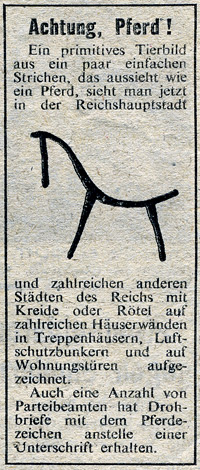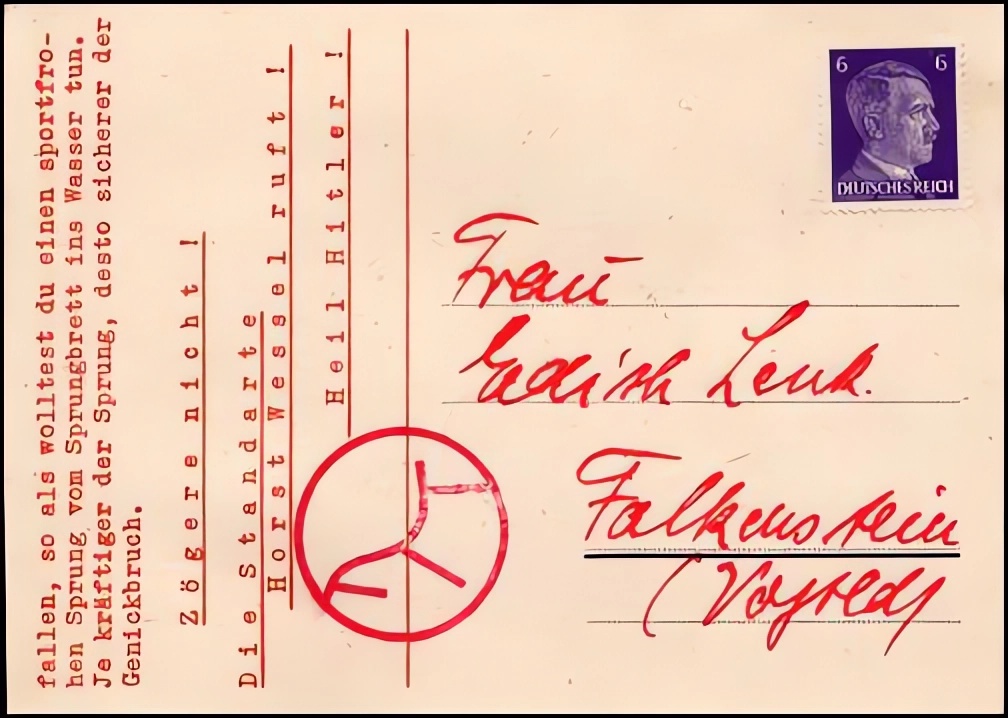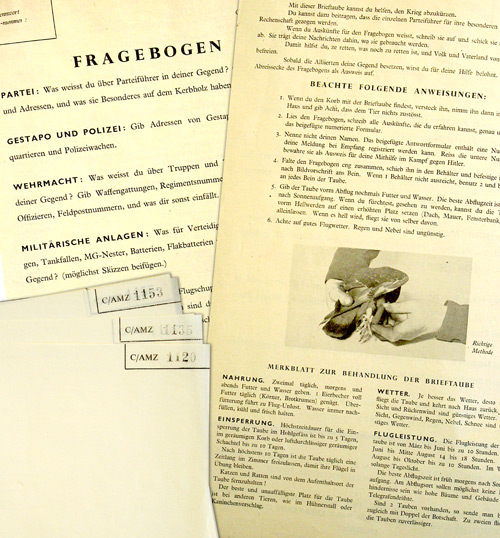Operation Periwig on:
[Wikipedia]
[Google]
[Amazon]
 Operation Periwig was a secret service operation planned and carried out by the British Special Operations Executive (SOE) from November 1944 onwards during the Second World War. The aim was to disrupt the Nazi regime by feigning resistance movements within the German territory.
At the beginning of the war, the British secret service authorities were aware that it was practically impossible to establish a real resistance movement in Germany. Due to the almost insurmountable surveillance by the German security organs, it was considered hopeless to attempt creating such a complex structure, especially since all British agents deployed in Germany were exposed and arrested right at the beginning of the war.
In cooperation with the Political Warfare Executive (PWE) and the
Operation Periwig was a secret service operation planned and carried out by the British Special Operations Executive (SOE) from November 1944 onwards during the Second World War. The aim was to disrupt the Nazi regime by feigning resistance movements within the German territory.
At the beginning of the war, the British secret service authorities were aware that it was practically impossible to establish a real resistance movement in Germany. Due to the almost insurmountable surveillance by the German security organs, it was considered hopeless to attempt creating such a complex structure, especially since all British agents deployed in Germany were exposed and arrested right at the beginning of the war.
In cooperation with the Political Warfare Executive (PWE) and the  To support the SOE for ''Periwig'', the PWE took over some tasks related to the printing of propaganda material from March 1945. After a new resistance cell called "Red Horse" had been invented for the operation, the PWE also distributed printed material with the horse symbol of the pretended resistance group. The professed goal of this group was the execution of high-ranking Nazi
To support the SOE for ''Periwig'', the PWE took over some tasks related to the printing of propaganda material from March 1945. After a new resistance cell called "Red Horse" had been invented for the operation, the PWE also distributed printed material with the horse symbol of the pretended resistance group. The professed goal of this group was the execution of high-ranking Nazi  The final action of ''Operation Periwig'' consisted of the extraordinary plan to use
The final action of ''Operation Periwig'' consisted of the extraordinary plan to use
 Operation Periwig was a secret service operation planned and carried out by the British Special Operations Executive (SOE) from November 1944 onwards during the Second World War. The aim was to disrupt the Nazi regime by feigning resistance movements within the German territory.
At the beginning of the war, the British secret service authorities were aware that it was practically impossible to establish a real resistance movement in Germany. Due to the almost insurmountable surveillance by the German security organs, it was considered hopeless to attempt creating such a complex structure, especially since all British agents deployed in Germany were exposed and arrested right at the beginning of the war.
In cooperation with the Political Warfare Executive (PWE) and the
Operation Periwig was a secret service operation planned and carried out by the British Special Operations Executive (SOE) from November 1944 onwards during the Second World War. The aim was to disrupt the Nazi regime by feigning resistance movements within the German territory.
At the beginning of the war, the British secret service authorities were aware that it was practically impossible to establish a real resistance movement in Germany. Due to the almost insurmountable surveillance by the German security organs, it was considered hopeless to attempt creating such a complex structure, especially since all British agents deployed in Germany were exposed and arrested right at the beginning of the war.
In cooperation with the Political Warfare Executive (PWE) and the Secret Intelligence Service
The Secret Intelligence Service (SIS), commonly known as MI6 ( Military Intelligence, Section 6), is the foreign intelligence service of the United Kingdom, tasked mainly with the covert overseas collection and analysis of human intelligenc ...
(SIS), a plan was therefore developed to invent a suitable resistance movement. This measure was intended to involve the German security organs in practically useless activities in order to track down the alleged resistance fighters. The intention was to create confusion and tie up important resources. It was also hoped - after something had possibly been leaked among the German population about such resistance movements - that one or the other courageous German would actually support these activities.
In November 1944 the planning group of ''Operation Periwig'' worked out a total of eight different scenarios for a hypothetical resistance movement. For this purpose, groups of people within the Wehrmacht, the party and police, the Roman Catholic Church, industrialists, industrial and mining workers, foreign workers, separatists
Separatism is the advocacy of cultural, ethnic, tribal, religious, racial, governmental or gender separation from the larger group. As with secession, separatism conventionally refers to full political separation. Groups simply seeking greate ...
and members of the Reichsbahn were considered as possible resistance fighters.
As an example, the Wehrmacht resistance movement was to be assigned its headquarters in Berlin. Gdańsk
Gdańsk ( , also ; ; csb, Gduńsk;Stefan Ramułt, ''Słownik języka pomorskiego, czyli kaszubskiego'', Kraków 1893, Gdańsk 2003, ISBN 83-87408-64-6. , Johann Georg Theodor Grässe, ''Orbis latinus oder Verzeichniss der lateinischen Benen ...
, Dresden, Hamburg, Nuremberg and other important cities in Germany were invented as further locations for resistance cells. All cells were to be connected with each other through regular Wehrmacht- as well as personal contact. The office of the Wehrmacht resistance movement in London, which was under British control, would be in constant contact with the headquarters in Berlin. Two selected German prisoners of war
A prisoner of war (POW) is a person who is held Captivity, captive by a belligerent power during or immediately after an armed conflict. The earliest recorded usage of the phrase "prisoner of war" dates back to 1610.
Belligerents hold priso ...
would be able to carry out activities in Germany between the individual cells and communicate with Britain in a variety of ways. In addition, numerous other persons employed as agents would be able to maintain regular contact with London. Correspondingly, for all other hypothetical resistance movements, similar procedures were worked out as would have been expected from actually existing resistance groups.
In order to draw attention to the alleged resistance movement in Germany, suitable deceptive measures were devised. For example, containers with weapons, ammunition
Ammunition (informally ammo) is the material fired, scattered, dropped, or detonated from any weapon or weapon system. Ammunition is both expendable weapons (e.g., bombs, missiles, grenades, land mines) and the component parts of other weap ...
, propaganda
Propaganda is communication that is primarily used to influence or persuade an audience to further an agenda, which may not be objective and may be selectively presenting facts to encourage a particular synthesis or perception, or using loaded ...
material, food and the like were to be dropped by aeroplane over imaginary supply points of the ostensible resistance movement.
When the plan to carry out the operation took on a more concrete form in January 1945, objections were raised above all by the SIS, which feared that its own plans to indoctrinate the enemy could be thwarted by ''Periwig''. An alleged support of hypothetical resistance cells could endanger actually existing anti-Nazi groups in Germany. However, when the concerns of the SIS were dispelled in mid-February 1945, ''Operation Periwig'' was able to start, which began with manipulated radio messages to Germany. From 21 February 1945, the first containers with supplies and forged information material for the alleged resistance cells were dropped by plane. However, these operations were suspended again from mid-March 1945, as the Supreme Headquarters Allied Expeditionary Force
Supreme Headquarters Allied Expeditionary Force (SHAEF; ) was the headquarters of the Commander of Allied forces in north west Europe, from late 1943 until the end of World War II. U.S. General Dwight D. Eisenhower was the commander in SHAEF th ...
(SHAEF) feared that the Gestapo could misuse such drops of weapons or material near POW camps to commit the murder of Allied
An alliance is a relationship among people, groups, or states that have joined together for mutual benefit or to achieve some common purpose, whether or not explicit agreement has been worked out among them. Members of an alliance are called ...
prisoners.
Finally, in early to mid-April 1945, a number of trustworthy German prisoners of war were dropped as alleged agents over German territory. There they were to perform various conspiratorial
A conspiracy theory is an explanation for an event or situation that invokes a conspiracy by sinister and powerful groups, often political in motivation, when other explanations are more probable.Additional sources:
*
*
*
* The term has a nega ...
activities for the claimed resistance cells. The prisoners of war were not aware that these cells did not exist in reality.
 To support the SOE for ''Periwig'', the PWE took over some tasks related to the printing of propaganda material from March 1945. After a new resistance cell called "Red Horse" had been invented for the operation, the PWE also distributed printed material with the horse symbol of the pretended resistance group. The professed goal of this group was the execution of high-ranking Nazi
To support the SOE for ''Periwig'', the PWE took over some tasks related to the printing of propaganda material from March 1945. After a new resistance cell called "Red Horse" had been invented for the operation, the PWE also distributed printed material with the horse symbol of the pretended resistance group. The professed goal of this group was the execution of high-ranking Nazi functionaries
An official is someone who holds an office (function or mandate, regardless whether it carries an actual working space with it) in an organization or government and participates in the exercise of authority, (either their own or that of their ...
. In order to draw more attention to this goal among the German population, agents were commissioned to place this horse symbol on various buildings or objects while postcards were sent to prominent Germans containing threatening texts and showing the Red Horse symbol. For example, the recipients were asked to commit suicide, with the hidden meaning that this was more honourable than being liquidated by the resistance group "Red Horse".
On 7 March 1945, an article appeared in the German Wehrmacht magazine ''Nachrichten für die Truppe'' (News for the troops) with the headline ''Sonderbewachung für bedrohten Gauleiter''. (Special surveillance for threatened Gauleiter) It described that three additional armoured vehicles and 24 men of the NSKK, under the leadership of Major
Major (commandant in certain jurisdictions) is a military rank of commissioned officer status, with corresponding ranks existing in many military forces throughout the world. When used unhyphenated and in conjunction with no other indicators ...
Ludwig Läubl, would be deployed to protect the 37-year-old Gauleiter of Westphalia South, Albert Hoffmann. This additional effort would be necessary, it said, as numerous party members have recently been liquidated in the Rhine-Ruhr area. It is believed that Gauleiter Hoffmann is one of the next candidates for an assassination attempt. This description was followed by a list of Nazi members who already had been liquidated and ended with the text that now also the mayor of Bochum
Bochum ( , also , ; wep, Baukem) is a city in North Rhine-Westphalia. With a population of 364,920 (2016), is the sixth largest city (after Cologne, Düsseldorf, Dortmund, Essen and Duisburg) of the most populous Germany, German federal state o ...
, Dr. Piclum, had disappeared without a trace. He, too, had received several threatening letters, which only showed the red horse symbol as signature.
 The final action of ''Operation Periwig'' consisted of the extraordinary plan to use
The final action of ''Operation Periwig'' consisted of the extraordinary plan to use carrier pigeons
The homing pigeon, also called the mail pigeon or messenger pigeon, is a variety of domestic pigeons (''Columba livia domestica'') derived from the wild rock dove, selective breeding, selectively bred for its ability to find its way home over e ...
as spy assistants. For this purpose, from 4 April 1945 pigeons were packed in containers attached to parachute
A parachute is a device used to slow the motion of an object through an atmosphere by creating drag or, in a ram-air parachute, aerodynamic lift. A major application is to support people, for recreation or as a safety device for aviators, who ...
s. These containers were then dropped over enemy territory. A small capsule was fixed to a pigeon leg, which contained a questionnaire, a pencil and instructions to ensure the safe return of the pigeons to England. The aim was that the pigeons would land in German towns, be found there by cooperative residents and the questions answered. Afterwards they were to be sent back to England with the information gained, for instance troop strength near the village. Out of a total of 330 pigeons used, only nine returned to England and two flew to France. Among the returned pigeons, five capsules contained return messages, whereby only one was useful.
Overall, ''Operation Periwig'' is considered a failure. Apart from the severe restrictions imposed by the SIS and SHAEF, the actions during the war were also too late. Through earlier planning, a free hand in the actions and full support from other intelligence institutions, ''Operation Periwig'' could possibly have made a significant contribution to the overthrow of the Nazi regime.
References
Sources
* Fredric Boyce: ''SOE's ultimate deception: Operation Periwig'', Stroud: Sutton, 2005, {{ISBN, 0-7509-4027-1. Propaganda organizations Special Operations Executive Propaganda techniques using information